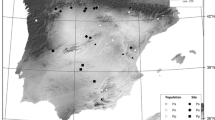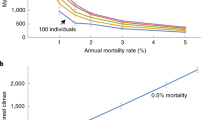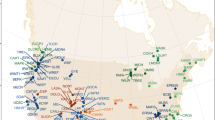Abstract
Climate response functions for 125 Pinus contorta populations were updated to assess the impact of 16 climate change scenarios on forest productivity. Productivity was defined as the volume of wood expected per hectare at age 20 and was calculated as the product of predicted individual tree volumes, an initial stocking (1600 trees ha−1), and predicted survival. Impact was considered according to the transient effects of a changing climate governed by (1) physiological plasticity in the contemporary generation and (2) long-term evolutionary adjustments that provide adaptedness and optimize productivity in future generations. Direct short-term plastic responses were geographically complex and had repercussions throughout the species' distribution even when temperature fluctuations were small (± 1 ° C) and changes in distribution were inconsequential. Evolutionary adjustments ameliorated negative short-term impacts while enhancing the positive. Scenarios that encompassed predictions for global warming produced short-term impacts that were negative in the south and positive in the north, but subsequent evolutionary adjustments projected substantial increases in productivity. The long-term adjustments may require only 1 to 3 generations in the north but 6 to 12 generations in the south, thereby taking between 200 and 1200 years.
Similar content being viewed by others
REFERENCES
Arthur, W.: 1987, The Niche in Competition and Evolution, Wiley and Sons, New York, NY.
Benson, R. E.: 1982, Management Consequences of Alternative Harvesting and Residue Treatment Practices – Lodgepole Pine, U.S. Department of Agriculture, Forest Service, Intermountain Forest and Range Experiment Station, General Technical Report INT-132, Ogden, UT.
Betancourt, J. L.: 1990, 'Late Quaternary Biogeography of the Colorado Plateau', in a Betancourt, J. L., Van Devender, T.R., and Martin, P. S. (eds.), Packrat Middens, the Last 40,000 Years of Biotic Change, University Arizona Press, Tucson, AZ.
Box, E. O., Crumpacker, D. W., and Hardin, E. D.: 1993, 'A Climatic Model for Location of Plant Species in Florida, U.S.A.', J. Biogeogr. 20, 629–644.
Box, E. O., Crumpacker, D. W., and Hardin, E. D.: 1999, 'Predicted Effects of Climatic Change on Distribution of Ecologically Important Native Tree and Shrub Species in Florida', Clim. Change 41, 213–248.
Bradshaw, A. D.: 1965, 'Evolutionary Significance of Phenotypic Plasticity in Plants', Adv. Genet. 13, 115–155.
Davis, M. B.: 1989, 'Lags in Vegetation Response to Greenhouse Warming', Clim. Change 15, 75–82.
DeLucia, E. H., Hamilton, J. G., Naidu, S. L., Thomas, R. B., Andrews, J. A., Finzi, A., Lavine, M., Matamala, R., Mohan, J. E., Hendrey, G. R., and Schlesinger, W. H.: 1999, 'Net Primary Production of a Forest Ecosystem with Experimental CO2 Enrichment', Science 284, 1177–1179.
Falconer, D. S.: 1981, Introduction to Quantitative Genetics, Longman Press, London, U.K.
Ferguson, S. A.: 1997, A Climate-Change Scenario for the Columbia River Basin, U.S. Dept. Agric., Forest Service, Pacific Northwest Research Station, Portland, OR, PNW-RP-499.
Futuyma, D. J.: 1997, Evolutionary Biology, Sinauer Associates, Inc., Sunderland, MA.
Giorgi, F., Brodeur, C. S., and Bates, G. T.: 1994, 'Regional Climate-Change Scenarios over the United States Produced with a Nested Regional Climate Model', J. Climate 7, 375–399.
Husch, G., Miller, E. I., and Beers, T. W.: 1972, Forest Mensuration, Ronald Press, New York, NY.
Hutchinson, G. E.: 1958, 'Concluding Remarks', Cold Spring Harbor Symp. Quant. Biol. 22, 415–427.
Illingworth, K.: 1978, 'Study of Lodgepole Pine Genotype-Environment Interaction in B.C.', in Proceedings IUFRO Joint Meeting of Working Parties: Douglas-Fir Provenances, Lodgepole Pine Provenances, Sitka Spruce Provenances and Abies Provenances, Vancouver, B.C., pp. 151–158.
IPCC (Intergovernmental Panel on Climate Change): 1996a, 'ClimateModels – Projections of Future Climate', Chapter 6, Climate Change 1995 – The Science of Climate Change, Contributions of Working Group 1 to the Second Assessment Report of the Intergovernmental Panel on Climate Change, Cambridge University Press, Cambridge, U.K.
IPCC (Intergovernmental Panel on Climate Change): 1996b, 'Terrestrial Biotic Responses to Environmental Change and Feedbacks to Climate', Chapter 9, Climate Change 1995 – The Science of Climate Change, Contributions of Working Group 1 to the Second Assessment Report of the Intergovernmental Panel on Climate Change, Cambridge University Press, Cambridge, U.K.
Iverson, L. R. and Prasad, A. M.: 1998, 'Predicting Abundance of 80 Tree Species Following Climate Change in the Eastern United States', Ecol. Monog. 68, 465–485.
King, G. A. and Neilson, R. P.: 1992. 'The Transient Response of Vegetation to Climate Change: A Potential Source of CO2 to the Atmosphere', Water Air Soil Pollut. 64, 365–383.
Kozak, A.: 1988, 'A Variable-Exponent Taper Equation', Can. J. Forest Res. 18, 1363–1368.
Kurz, W. A., Apps, M. J., Stocks, B. J., and Volney, J. A.: 1995. 'Global Climate Change: Disturbance Regimes and Biospheric Feedbacks of Temperate and Boreal Forests', in Woodwell, G. M. and Mackenzie, F. T. (eds.), Biotic Feedbacks in the Global Climatic System, Oxford University Press, New York, NY.
Mitchell, K. J., Grout, S. E., and Macdonald, R. N.: 1995, 'User's Guide for Producing Managed Stand Yield Tables with WinTIPSY Version 1.3 under Microsoft Windows', Ministry of Forests, Research Branch, Victoria, B.C.
Monserud, R. A., Tchebakova, N. M., and Leemans, R.: 1993: 'Global Vegetation Change Predicted by the Modified Budyko Model', Clim. Change 25, 59–83.
Nuszdorfer, F. C., Klinka, K., and Demarchi, D. A.: 1991, 'Coastal Douglas-fir Zone', in Meidinger, D. and Pojar, J. (eds.), Ecosystems of British Columbia, British Columbia Ministry of Forests, Special Report Series, No. 6, Victoria, B.C., pp. 81–94.
Overpeck, J. T. and Bartlein, P. J.: 1989, 'Assessing the Response of Vegetation to Future Climate Change: Ecological Response Surfaces and Paleoecological Model Validation', The Potential Effects of Global Climate Change on the United States, Appendix D, Forests, United States Environmental Protection Agency Report PM-221.
Pielou, E. C.: 1991, After the Ice, University Chicago Press, Chicago, IL.
Prentice, I. C., Cramer, W., Harrison, S. P., Leemans, R., Monserud, R. A., and Solomon, A. M.: 1992, 'A Global Biome Model Based on Plant Physiology and Dominance, Soil Properties, and Climate', J. Biogeogr. 19, 117–134.
Rehfeldt, G. E.: 1985, 'Genetic Variances and Covariances in Pinus contorta: Estimates of Genetic Gains from Index Selection', Silvae Genet. 34, 26–33.
Rehfeldt, G. E.: 1990, 'Adaptation of Picea engelmanii Populations to the Heterogeneous Environments of the Intermountain West', Can. J. Bot. 72, 1197–1208.
Rehfeldt, G. E.: 1997, 'Quantitative Analyses of the Genetic Structure of Closely Related Conifers with Disparate Distributions and Demographics: The Cupressus arizonica Complex', Amer. J. Bot. 84, 190–200.
Rehfeldt, G. E., Ying, C. C., Spittlehouse, D. L., and Hamilton, D. A.: 1999, 'Genetic Responses to Climate in Pinus contorta: Niche Breadth, Climate Change, and Reforestation', Ecol. Monog. 69, 375–407.
Smith, T. M. and Shugart, H. H.: 1993. 'The Transient Response of Terrestrial Carbon Storage to a Perturbed Climate', Nature 361, 523–526.
Smith, T.M., Shugart, H. H., Bonan, G. B., and Smith, J. B.: 1992, 'Modeling the Potential Response of Vegetation to Global Climate Change', Adv. Ecol. Res. 22, 93–116.
Solomon, A. M. and Kirilenko, A. P.: 1997, 'Climate Change and Terrestrial Biomass:What If Trees Do Not Migrate?', Global Ecol. Biogeog. Lett. 6, 139–148.
Tackle, D.: 1959, Silvics of Lodgepole Pine, U.S. Department of Agriculture, Forest Service, Intermountain Forest and Range Experiment Station Miscellaneous Publication 19, Ogden, UT.
Vyse, A. and Navratil, S.: 1985, 'Advances in Lodgepole Pine Regeneration', in Baumgartner, D.M., Krebil, R. G., Arnott, J. T., and Weetman, G. F. (eds.), Lodgepole Pine: The Species and its Management
Spokane, WA and Vancouver, B.C., 1984, Washington State University, Cooperative Extensive Service, Pullman, WA, pp. 173–186.
Webb, T. III, 1986.: 'Is Vegetation in Equilibrium with Climate? How to Interpret Late-Quaternary Pollen Data', Vegetatio 67, 75–91.
Wheeler, N. C. and Critchfield, W. B.: 1985. 'The Distribution and Botanical Characteristics of Lodgepole Pine', in Baumgartner, D. M., Krebil, R. G., Arnott, J. T., and Weetman, G. F. (eds.), Lodgepole Pine: The Species and its Management, Spokane, WA and Vancouver, B.C., 1984, Washington State University, Cooperative Extensive Service, Pullman, WA, pp. 1–14.
Wigley, T.M. L. and Raper, S. C. B.: 1992, 'Implications for Climate and Sea Level of Revised IPCC Emissions Scenarios', Nature 357, 293–300.
Woodwell, G. M.: 1995, 'Biotic Feedbacks from the Warming of the Earth', in Woodwell, G. M. and Mackenxie, F. T. (eds.), Biotic Feedbacks in the Global Climatic System, Oxford University Press, New York, NY.
Xie, C. and Ying, C. C.: 1995, 'Genetic Architecture and Adaptive Landscape of Interior Lodgepole Pine (Pinus contorta ssp. latifolia) in Canada', Can. J. Forest Res. 25, 2010–2021.
Ying, C. C. and Liang, Q.: 1994, 'Geographic Pattern of Adaptive Variation of Lodgepole Pine (Pinus contorta Dougl.) within the Species' Coastal Range: Field Performance at Age 20 Years', Forest Ecol. Manage. 67, 281–298.
Author information
Authors and Affiliations
Rights and permissions
About this article
Cite this article
Rehfeldt, G.E., Wykoff, W.R. & Ying, C.C. Physiologic Plasticity, Evolution, and Impacts of a Changing Climate on Pinus Contorta. Climatic Change 50, 355–376 (2001). https://doi.org/10.1023/A:1010614216256
Issue Date:
DOI: https://doi.org/10.1023/A:1010614216256




